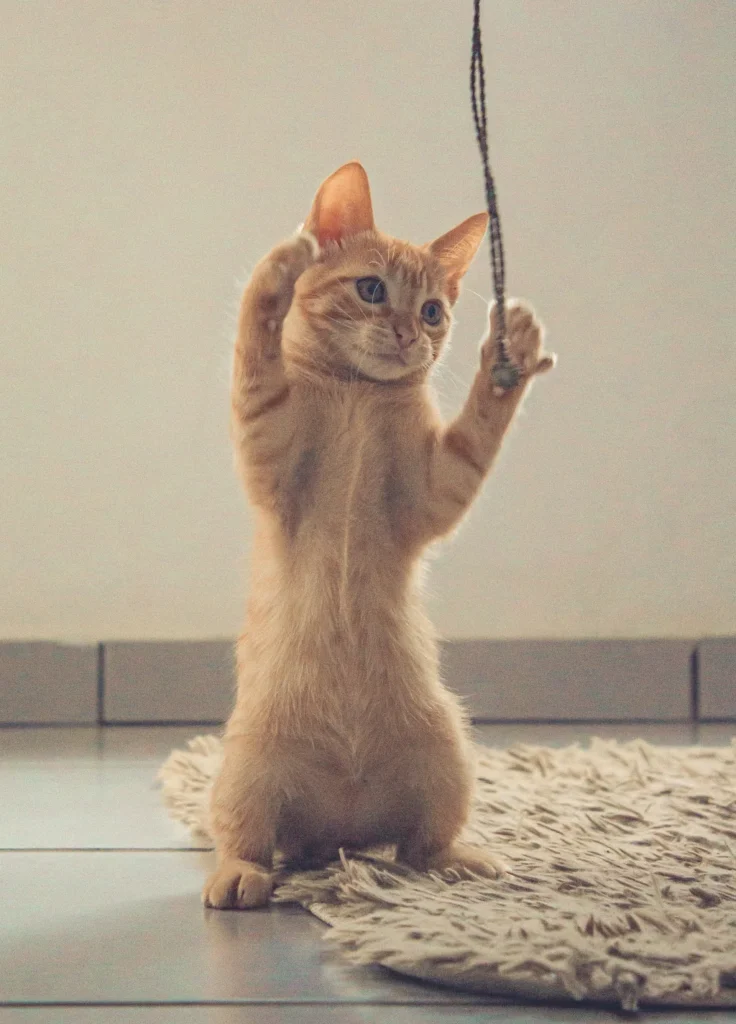Disclosure: We may earn a commission from helpful, relevant links in our content. No cost to you. See our privacy policy.
Ready to whip your feline into tip-top shape?
Ensuring your cat gets enough exercise might feel like herding cats – frustrating, almost impossible, and met with a hefty dose of indifference.
As an indoor cat parent, you’ve probably experienced your fair share of catnaps and nonchalant stares as you wave toys in vain. But, let’s pause for a minute – imagine a world where your cat chases after the laser pointer with gusto, actually using that expensive scratching post.
Let’s dive into turning that dream into reality.

Why Cats Need Regular Exercise
Without a doubt, exercise plays a crucial role in your cat’s health and happiness.
It’s not just about keeping the pounds off – although that is certainly important. Regular physical activity keeps your cat’s heart healthy, their muscles toned, and their mind sharp.
Let’s not forget that exercise can help reduce the risk of behavioral problems that often stem from boredom or frustration.
From clawing your favorite couch to nighttime zoomies that keep you up, many of these behaviors can be mitigated by ensuring your cat is sufficiently engaged and exercised.
How Much Exercise Does Your Cat Need?
The “one-size-fits-all” approach doesn’t quite work here.
The amount of exercise a cat needs can depend on its age, health, and natural disposition. However, a general guideline is around 10-15 minutes of active play several times a day.
Kittens and young adult cats may need more. Keep in mind that you should balance high-energy play sessions with ample rest time. Exercising your cat is like seasoning a meal – too little and it’s bland, too much and it’s overwhelming.
Find the balance that suits your particular feline.
Here is a simple table for the exercise needs of different aged cats:
| Age | Activity Level | Activities |
| Kittens | High | Toys, Balls, Feathers |
| Adults | Moderate | Lasers, Puzzles, Climbing |
| Seniors | Low | Soft Toys, Gentle Play, Walking |
What Are Some Exercise Solutions for Indoor Cats?
Transforming your home into a feline-friendly playground isn’t as tricky as it might sound.
One effective solution is setting up cat trees and shelves. They provide vertical space for your cat to climb and survey their territory, mimicking their natural outdoor environment.
An often overlooked but unique solution is clicker training. Yes, you read that right. Training isn’t just for dogs. Engaging your cat’s mind with a touch of obedience training not only challenges them mentally but also creates an opportunity for some light physical activity.
For starters, why not train your cat to come to you when called? It’s just like training a dog, except the cat doesn’t really want to please you. But there’s a trick to it, so check that blog post out.
Another idea is to incorporate feeding time into exercise time. There are puzzle feeders available that require your cat to work for their food. This stimulates their hunting instincts and also slows down fast eaters, preventing health issues like vomiting or overeating.
If your cat still doesn’t want to play, we have some more solutions to encourage your cat to play that might work for you.

Fun and Creative Exercise Ideas for Cats
Inject some fun into your cat’s exercise routine with creative ideas.
Think outside the box – literally. Try turning an empty box into a playhouse. Cut out some holes and hide toys or treats inside. Your cat will have a blast trying to retrieve them.
For the tech-savvy cat parents, how about a game app designed for cats? There are numerous apps available that simulate moving objects like fish or insects on the screen. Your cat can “hunt” by pawing at the screen, and you get to enjoy watching their antics.
For this activity, phones can work, but we’ve seen the best results with tablets and iPads. So get yourself a tablet or iPad, and you’ll see why! There are many options, and it doesn’t have to be expensive.
One app we’ve seen cats enjoy time and again is Cat Fishing 2 (app store) – it’s loaded with interactive games that’ll keep your furball intrigued.
Remember, the key to a successful exercise routine is variety. Keep trying new things and see what clicks with your feline. Every cat is unique, and what works for one might not work for another.
The most important thing is to make exercise a routine part of your cat’s life and have fun while doing it!
How to Encourage Your Cat to Exercise More?
Motivating your cat to exercise more requires patience and a dash of creativity.
Tailor your approach to your cat’s unique preferences. Some cats might be drawn to a new toy or a change of scenery, such as a window perch for bird watching.
Let me share a quick story. My male cat, Smokey, was becoming less active as he aged. It was a bit concerning. One day, I decided to experiment with a laser pointer – something I’d overlooked before because it seemed too simple.
To my surprise, Smokey couldn’t resist that little red dot. He would leap, pounce, and chase after it with an energy I hadn’t seen in years. It was a small addition to our routine, but it made a significant difference in his overall activity level.
The point here is, don’t be afraid to experiment until you find what motivates your cat.
Why wait? Start incorporating fun-filled playtime into your daily routine now, and watch as your cat transforms into a more active, healthier, and happier companion.
FAQs
How can I tell if my cat is getting enough exercise?
Monitor your cat’s weight, energy levels, and overall behavior. If your cat maintains a healthy weight, shows interest in playtime, and appears content, they’re likely getting enough exercise.
What exercises are safe for a kitten?
Kittens can safely engage in play-based exercises such as chasing toys or playing with other kittens. Remember to provide toys that are size-appropriate and don’t pose a choking hazard.
How can exercise help my cat’s digestion?
Exercise helps to stimulate intestinal movement, which aids in the digestion process. It can help prevent issues like constipation and promotes overall gut health.
What are the signs my cat might need more exercise?
Your cat might need more exercise if you observe any of these signs:
- Weight gain
- Restlessness
- Destructiveness
- Over-grooming
If you observe any of these signs, try introducing more physical activity into their routine.
Alex, a passionate animal lover, has experience in training and understanding animal behavior. As a proud pet parent to two dogs and three cats, he founded AnimalReport.net to share insights from animal experts and expand his knowledge of the animal kingdom.




